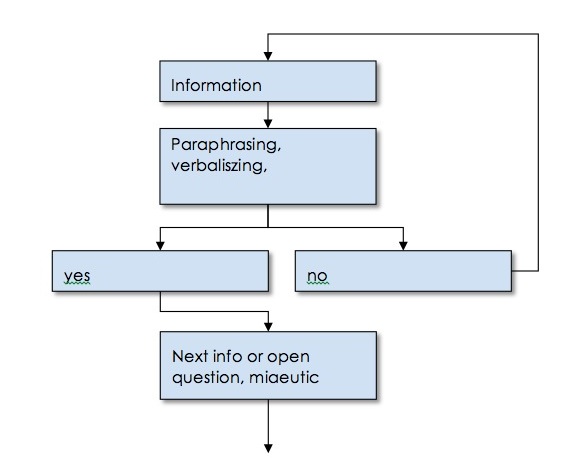Active listening is understood to be the mean of better understanding. The loop goes a bit deeper. The purpose is to mirror and to synchronize communication. Looping provides good results where people feel understood quite well.
Is it enough to find solutions where conflicts are limiting perception and thinking?
Acive listening means to show that I am listening. Ist primarily based on body language and para-verbal communication.
Looping means to mirror what was meant and expressed. It is to reconstruct thoughts and feelings of another person.
By the loop the listener enters the client’s world of thoughts. To not manipulate their thinking, the loop should not contain any other information than given by the sender. Looping includes the techniques of paraphrasing, verbalizing, anchoring and summarizing.
In fact the loop is much more than just a mirroring tool. It helps to adjust thinking and structuring. It helps to deal with complexity and to bring order in one’s brain. It helps to steer through a cognition process, which is described pretty well by the phases of mediation.
Eventually the loop will be enriched by the technique of maieutic. Now the loop becomes a multifunctional tool. That might be used wherever thoughts need to be (re) constructed.
The loop concept always works as precisely as the mediator’s thinking is. If that is true, the mediator’s attitude and his way of thinking determine the depth and quality of cognition and insights. Where mediation is a process of clarification precise thinking is a mean to verify and adjust thinking.
Precise listening is the technique achieving precise thinking. How does it work and what is the mediator (the listener) expected to do?
One of the main services the mediator is providing to the clients is to feed back his neutral meta-view. The listener should be able to see all the sides of a problem, relaying the persons behind. He is able to see the whole complexity even what is not becoming visible or seen by the clients. How can that be? The mediator is not smarter than the parties are. He even knows less about them and their conflict. The difference is just: He knows what he (and the parties) in fact doesn’t know. He knows what we ought to know for understanding the problem in its context.
A good attitude is where the mediator thinks he knows absolutely nothing. He should be naïve like a little child. The same time he should be wise like an old man. As a child he is curious to learn and scrutinizes everything. As an old man he is composed, not emotional and not having an opinion at all. Sokrates was an example for precise thinking. He became the inventor of maieutic. His believe was, that the truth is located inside of everybody; he just needs to help letting it out. His idea was to being convinced by the client – not to convince. Though he wanted to be convinced, he made it as difficult as possible to succeed. Sokrates’s attitude is perfectly supporting precise thinking.
Putting everything together, the attitude of Sokrates, Thomas von Aquin’s rules of disputing, the knowledge about perception, constructivism and communication we will find a tool which is to be seen an extended loop.
The principle of looping is shown below:
The most important element of the loop is paraphrasing. Even experts often miss using the technique, though paraphrasing and verbalizing is much more important than questioning. A good and fitting paraphrase mostly inspires people to continue talking themselves. No questions are needed then.
Paraphrasing is not only the mean for synchronizing communication. It also helps to synchronize thinking. The listener is due to check his own thinking. Where he askes the client: „Did I understand you correctly?“ He in the same time should ask himself: „Was that understandable where I suppose not to know anything? Was that a constant thought where one step builds on the other?“ Now the listener becomes critical. His loop is upgrading to become a very precise listening. The listener might confirm for example: „You said 1 comes before 2. Right?“ The client commits. The listener continues asking: „How can you know?“ The client answers: “It’s mathematics”. The listener asks: “I see. I wonder what is if there’s a count down?” The client answers: “Yes, then it’s the other way around”. Now the listener summarizes: “Then it’s possible that 1 is following 2 and the 2 is following 1, right?” The client agrees. The listener now continues: “It is depending on the direction of counting, right?”. The client agrees again. The listener now asks: “If it depends on the direction of counting, when do I know to count up or down?” and so on.
Confirming like that synchronizes not only communication. It synchronizes the thinking of listener and client the same time. The borders of thinking and the conditions become visible. Thoughts become bricks where one thought is settled on the other one like bricks, which are settled on each other until a building is coming out of it.
The listener knows that one brick is not the same as another one. Like the bricks, one thought is not the same as another thought. The listener knows thoughts change their meaning depending on the character they have. It might be compared with data storing also. A data like 123456 can be a text string. It also can be a digit. As a text it will be treated differently than a digit. A computer needs to know the character of data in order to treat them appropriately.
Where thoughts are bits of information they share this fate. Knowing the character of information helps to treat them appropriately. Emotional thoughts (feelings) express another meaning than rational thoughts (ideas). Facts are to be treated differently than opinions. The character of thoughts refers thinking on different levels and in different concerns. Separating thoughts and categorising hem helps to deal with complexity. This is a main mean where precise listening is superior to juridical thinking. In juridical thinking complexity is reduced on situations.
Precise listening deals with all the levels and concerns of thinking by structuring them. It’s more than just active listening and looping as it steers the client through the process of mediation as a mean for the process of thinking. It is brings order to the mess of the client’s brain.
Often mediation is declared to be a structured process. But its not the phases only giving structure. That would not be sufficient. The way of confirming is giving structure and head.
Now we can see the character (types) of thoughts like cases of a cupboard. The cases are for helping the listener to structure and to order his thoughts. The caption of each case is the character of information or the meta-type of it. Cases therefore can be:
- the phases of mediation (purpose of using the thought. Does it belong to phase one, two and so on. Phases are separated strictly. Thoughts will be concentrated on what each phase expects only. The thinking of solutions will be hindered where the phase is to discuss interests for example. This is meant to open the view and to dissolve it from solutions to be expected or not).
- the facts (facts are to be separated, as facts will be treated differently than opinions for example. There is no need to row about facts but to find how facts can be evidenced).
- the opinions (If people row about opinions, the question is why they need to have a common opinion).
- the emotions / feelings (feelings are facts that shouldn’t be doubted. They need to be recognized in order to treat them in a way. The mediator then could put them away or deal with them, depending if he wants facilitative or transformative mediation).
- the Ich-Botschaften (messages about the client help to find needs, interests and the benefit to be expected)
- the relationships which are targeted or concerned (separating the interests for each stakeholder).
- the level of relationship which is concerned (important in separation conflicts where relationship of parents has to survive the couple relationship. This might be possible where levels of relationship can be separated).
- the situation (subjecting the Halo Effect, working out the different perceptions on the same fact)
- the view oft he observer (subjecting the fundamental attribution error)
- the view of time (past, presence term)
- the interest / need behind (interests and solutions should be separated strictly)
- the solution to be expected
- and so on
How can the mediator / listener manage structuring like that?
While listening, the listener builds virtual cupboards in his brain, one for each client. Each cupboard has different cases. Then he puts information in fitting virtual cases of each cupboard as described before. When confirming, he gives the meta-information (the caption of the case where the information belongs to) back also. This sounds like: “You mentioned facts as follows …., right?” The client confirms. The listener continues: “The conclusion you take from that is …..”. The client confirms. The listener continues: “This again is causing emotions like …. Is that correct also?” The client confirms.
Now in mediation for example, which is a clarification process also, the listener is not only repeating what he understood. He is a very critical listener also. He for example recognizes what was not said. Hence the listener asks where cases stay empty or where information is missing: “You didn’t mention anything about …, right? “The client confirms. The listener continues: “What does it mean?”.
The listener tries to reconstruct what the client said. He is critical and wonders all the time: “Can it be?” or “Is that really clear, coherent and conclusive?”. He assures himself by asking: “You said …. How did you come to that conclusion?”
Arranging thoughts and categorizing them as described before, makes thoughts comparable and discussable on one level. The listener / mediator takes chare that thoughts will only be compared by thoughts of the same level and concern.
It is extremely important to always ask for commitments. Commitments should be taken and confirm each step of thinking on different levels and cupboard-cases. This is to assure that thoughts became bricks in the brain of the client.
It’s a principle of precise listening to not think in the heads of others but to let the clients think instead. The challenge in paraphrasing and verbalizing is to not put more information in than the client wanted to provide himself. This needs the listener to not think forward like in linear communication, where the receiver determines meaning and course of an exchange. It needs to think in a reflecting way. The listener neither has solutions nor assessments in his mind. He makes everything transparent to the clients and let them deal with the phenomena, which becomes visible that way. The clients will be the ones who will find the solution then.





Excellent contribution that clearly shows that active listening is not just a technique, but also a state of mind. However, isn’t your idea of „precise listening“ already included in the „active listening“ technique? Indeed, by paraphrasing, we can make sure that we’ve correctly understood the interlocutor’s message? Thanks,
Thanks. Yes sure the terms are overlapping. Active listening for example is mirroring primarily. It involves the feelings. Paraphrasing steps deeper. It scrutinizes the meaning behind. Both is dedicated to synchronize communication and understanding. Precise listening goes still more deeper. This is not just to secure correct understanding but also reflecting the validity of information. So it is not just giving feedback but scrutinizing the logic behind. So it is synchronizing thinking and mind also.